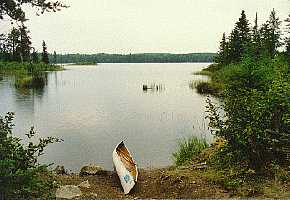Wind Bound on Cache PointA Canoe Trip Adventure Story We don't know it, but the most memorable event of the trip is yet to come, a passage that will test our teamwork, strength, and nerve... |
A day of rain, a day of calm, and then, the wind. It starts late in the morning as we make our way across Saganagons, toward Silver Falls portage. Behind us are six days of great September fishing, and the eight portages from Kawnipi lake.
In the sheltered narrows leading out of Sagnagons, we hear the wind up in the poplar trees, waking them, rustling their leaves, making them sway and nod and bow before the great power in the sky. A nice breeze will be welcome on the portage - it'll keep us cool and keep the mosquitoes away. Keith and I should be through the portage in about an hour, and with any luck, we'll land our canoe at the end of the Gunflint Trail late in the afternoon. A few minutes later, our canoe touches the rough shore of a deserted portage landing. On this trip we packed for comfort and fishing, not for travel. We haven't been able to make only one trip through the portages. I bring the canoe up on shore and stash it off the path so other people won't trip over our gear. Silver falls is a major gateway into Quetico park, and even this late in the season, I expect to meet other groups coming in.
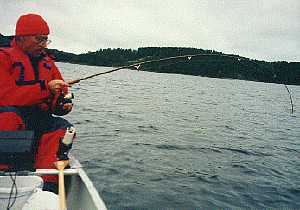 Walking through the portage, I think back on the
last eight days. I've been to Quetico over a dozen times,
but never did a lot of fishing. My partner, Keith
Mueller, is a great fisherman, but this is his first
canoe trip. Our trip began on a cloudy, windless Sunday,
after an eleven hour drive from Milwaukee, Wisconsin.
After stopping at Canadian customs, we paddled our way to
the Cache Bay ranger station where Jan Matichuk, the
ranger, was already starting to pack up shop. We paid our
park entry fee, bought fishing licenses, and started up
the "Falls Chain" of portages that lead to
Kawnipi Lake. Arriving the next day, we battled a head
wind past the fire-damaged half of Kawnipi, and pulled up
to a rocky island campsite in McKenzie Bay.
Walking through the portage, I think back on the
last eight days. I've been to Quetico over a dozen times,
but never did a lot of fishing. My partner, Keith
Mueller, is a great fisherman, but this is his first
canoe trip. Our trip began on a cloudy, windless Sunday,
after an eleven hour drive from Milwaukee, Wisconsin.
After stopping at Canadian customs, we paddled our way to
the Cache Bay ranger station where Jan Matichuk, the
ranger, was already starting to pack up shop. We paid our
park entry fee, bought fishing licenses, and started up
the "Falls Chain" of portages that lead to
Kawnipi Lake. Arriving the next day, we battled a head
wind past the fire-damaged half of Kawnipi, and pulled up
to a rocky island campsite in McKenzie Bay.
Worn out and stiff, I started to make some dehydrated stew when Keith caught the first fish. For the next six days, he never stopped catching fish. On a typical day, we would go out at seven A.M., and return by eight with the proper size walleyes for lunch and dinner. THEN we would go out fishing! For me, it was six days of fishing school in one of the best fishing areas I'll see in my lifetime.
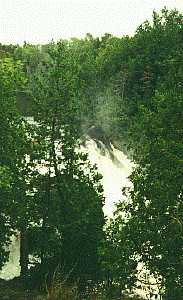 I smile as I carry the canoe on this last
portage of the season. With my traveling experience, and
Keith's tremendous knowledge of fishing, we make quite a
team. Overhead, tree tops bend and shake, now obediant,
now perhaps fearful of the wind above. Ahead, the wind
will join the vast waters of big Saganaga Lake. We don't
know it, but the most memorable event of the trip is yet
to come; a passage that will test our teamwork, strength,
and nerve.
I smile as I carry the canoe on this last
portage of the season. With my traveling experience, and
Keith's tremendous knowledge of fishing, we make quite a
team. Overhead, tree tops bend and shake, now obediant,
now perhaps fearful of the wind above. Ahead, the wind
will join the vast waters of big Saganaga Lake. We don't
know it, but the most memorable event of the trip is yet
to come; a passage that will test our teamwork, strength,
and nerve.
As expected, we meet several groups of travelers on the portage.
"Where've you been?" "Where are you headed?" "How was the fishing?" We ask the questions and offer the answers. This is the small talk people share on portages in the wilderness. Once we get out of the big city, we seem to naturally revert to the idea that meeting other people, even if they are strangers, is a good thing.
"Good luck!" "Have a safe trip home!" We paddle upstream through the current, and the portage is behind us.;
Another narrows leads us past high stone cliffs, and after twenty minutes, opens to Cache bay. We must cross Cache bay and round Cache Point, a distance of several miles. The wind, now blowing solidly from the north-northwest, is raising waves on the southern part of Cache Bay. We'll follow the northern shore, so we should be in no trouble until we reach Cache Point.;
Our canoe, a rented Alumacraft 17 footer, is exceptionally stable, but, of course, not very fast. Several years ago, I measured the compartments in the canoe, and designed packs that would exactly fill them, without exposing any gear above the gunwales. This way of packing is superior to the "Duluth" pack method, since all of the weight of our gear is at the lowest point it can be. Additionally, there's no exposed pack material to catch the wind. As we near Cache Point, the waves pile up to almost two feet. Our canoe rides well, however, and we land in the lee shore after a one hour crossing.
A long channel runs from Cache Point to the American Point on the western end of big Saganaga Lake. Keith and I climb up the steep hill to the top of the point, and look east across the channel. We don't like what we see. The wind, now whipping out of the north, is plowing right through the heart of the channel. On the rocky eastern shore, where we must round the American Point, white capped waves are crashing and breaking.
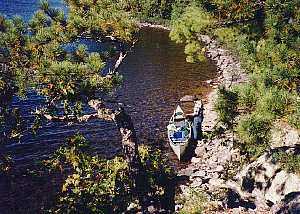 "Let's make some lunch", I say. I grab
at roots and brush as I make my way down the steep slope
to our canoe. An hour later, we sit down to a plate of
noodles and a cup of coffee.
"Let's make some lunch", I say. I grab
at roots and brush as I make my way down the steep slope
to our canoe. An hour later, we sit down to a plate of
noodles and a cup of coffee.
As we eat, we watch a party of three canoes battle upwind near the eastern shore. We can make it, I think to myself, but where would we be after rounding the American Point? After the point, there's a thirty- five minute paddle in the wide open waters of western Saganaga. We would be paddling with three miles of open water directly to our northwest. That's three miles for the wind to push on the water, to build up waves. As anxious as I am to finish the trip, I know that it would be a bad idea to push ahead now. The wind only becomes stronger as we wait, and by three o'clock it becomes apparent that Keith and I will spend the night on Cache Point.
Wind bound! I think back to other windy days in Quetico. There was the day when I traveled with my daughter Diana and her friend Karen through the Wawiag river on the northeast side of Kawnipi. The Wawiag is slow and winding, a mysterious channel that seems to draw your imagination just beyond the next bend. It's also sheltered water, safe from the menacing wind above. We came out of the river into Kawa Bay in the early afternoon. Two other canoes also came out, manned by young men that looked to be in excellent shape. Coming out into the open bay, a strong southern wind hit us head on. Rather than fight it, we pulled into shore and made early camp. The other canoes lit off into the wind, and were actually able to make some progress. By morning, the wind had died, and we paddled on toward the falls chain. We passed the young men at about ten o'clock, about six miles into the lake. Nothing stirred in their campsite - they were all still fast asleep!
On another trip with my son Mike and my friend Dave, we were crossing Saganaga with a stiff wind at our backs. I was so busy steering through the waves, and our speed was so great, that I missed a landmark and ended up getting lost in the eastern end of the lake. It took two hours of paddling and some help from an old guide before we were able to find our way in.
"We'll get an early start tomorrow morning" says Keith. "Three A.M." I agree. It should die down by then, and we should have smooth paddling and an early landing. I tell Keith about my trip with Karen and Diana, expecting the same outcome for us.
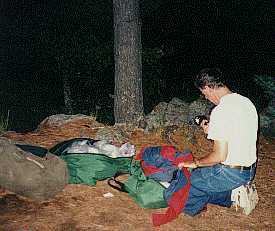 Keith starts to slip-bobber fish off the point,
and I set up our camp. Within an hour, Keith has a nice
size bass, and the last of our food is cooking on the gas
burner. Later that evening, we finish off our last pot of
coffee and listen to the wind blowing through the pines.
Overhead, in the darkening sky, clouds race past the
stars. The darkness closes around us, and the land feels
primitive, empty. As the temperature drops, we pack up as
much gear as we can and crawl into sleeping bags.
Keith starts to slip-bobber fish off the point,
and I set up our camp. Within an hour, Keith has a nice
size bass, and the last of our food is cooking on the gas
burner. Later that evening, we finish off our last pot of
coffee and listen to the wind blowing through the pines.
Overhead, in the darkening sky, clouds race past the
stars. The darkness closes around us, and the land feels
primitive, empty. As the temperature drops, we pack up as
much gear as we can and crawl into sleeping bags.
I'm tired, but my mind won't rest. A gust of wind rattles the tent, and carries my imagination out into the darkness. I think of the endless land around us, the broken trees, the darkened rocky shores. Out on Sag, the water must be pretty wild. On one of our first trips to the boundary waters, when we tried to cross Seagull lake on a windy day, I pulled out from behind a point of land with my son Mike, and managed to turn the canoe into the wind. The waves were so high that we had to back the boat into shelter. I remember that the waves scared me then. I've had many years of lake canoeing experience since then, but here in the windy night, the memory makes me uneasy. I don't sleep well, and as the hours wear on, I notice little change in the strength of the wind.
My mental "alarm clock" wakes me up a few minutes before three.
"It's quieter out there" I think. "The wind died down - just as I expected it would." I stumble around in the pre-dawn darkness, gathering water, coffee and matches. Keith wakes up and we begin to take down the tent and pack the canoe. By four forty-five, we're on the water.
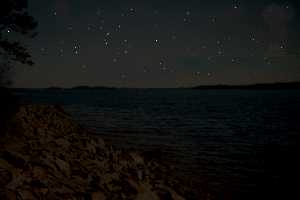 There is a little bit of wind, but not enough to
cause any trouble. The dim light of dawn reveals the wide
open channel that we follow to the north. Ahead lie the
open waters of western Saganaga. Within an hour, we
should be crossing this open water near the southern end.
We paddle steadily, Keith in the bow and I at the stern.
We're making good progress.
There is a little bit of wind, but not enough to
cause any trouble. The dim light of dawn reveals the wide
open channel that we follow to the north. Ahead lie the
open waters of western Saganaga. Within an hour, we
should be crossing this open water near the southern end.
We paddle steadily, Keith in the bow and I at the stern.
We're making good progress.
But as the light grows, so too does the wind. As we near the American Point, I find that I must be careful to keep the boat straight. If we fall off to the left or right, the wind will catch the boat and I'll have a hard time bringing us back on course. Now at the point, the waves buck us up and down as they build up in the shallows. We round the point and I quickly steer the canoe behind a small island. The wind did not leave us last night, it only rested as we rested. Awake now with the morning, it was looking down at big Saganaga. Here it found open water and a small canoe bobbing up and down in the waves, a small toy to play with. Two pairs of eyes looked up at the wind, wide eyes, wary and concerned.
I pause behind the island. To turn back would mean another day and night at the point, but this time with no food, no coffee... Two hours of paddling will see us to the landing. The most exposed part of our route lies ahead, from our small island near the American point to the gap between Long Island and Munker Island. The wind is not waiting - it seems to get stronger with every minute.
"Which way?" yells Keith. No hesitation from the front of the boat!
"East!" I yell, and we're off.
The pale light of early dawn does not show us the tiny gap between the islands, far to the east. Only an unbroken line of trees shows, and a picture in my head of other trips through this part of Saganaga. To the north - only open water, indigo sky and the strengthening wind. Normally I steer 102 degrees from the American point, but now I point us farther to the north. To miss the gap would be bad, and would strand us on the southern shore of the lake. Slow, undulating waves march in on our beam. We're parallel to the waves, and the canoe corkscrews slowly over each crest. As the wind comes in, the canoe and our bodies act as a sail, pushing the canoe's bow into the wind. I paddle on the left side of the boat to bring the bow to the right.
Ten minutes go by. I must widen my stroke, give myself more leverage to keep the boat straight. Another ten minutes, and we're more than half way to the gap. We're past the point of no return. I know it, Keith knows it, and the wind knows it. Rushing down from the North, it sends an army of waves to test our skill. Large, slow swells roll us from side to side. Choppy, chaotic waves play with our stroke. My hand goes under water as a wave comes up next to the boat. A few seconds later I stroke mostly air as the stern is lifted high on a wave crest. Mammoth crested waves threaten to overtake us and spill water into the canoe.
"Keith!" I yell. "Stay on the left side! I can't hold her!" No "J" stroke, draw stroke or other trick of paddling can hold us on course now. I can stroke once or twice on the left, then have to flip the paddle over to the right and steer. It's up to Keith to give us steerage way and get us to the gap. A big wave comes up alongside and lops half a bucket of water into the canoe. I must watch for these big ones, then turn us into them before they break over the gunwale.
"Where's the gap?" yells Keith. I point to our right. We're working our way north of the gap, into the howling wind. If we try to go straight in, we'll be swamped in a minute.
"We'll turn in a few minutes!" I yell back to Keith. Stroke, stroke, then flip and steer. Twenty yards, thirty, then turn the boat to meet a big one. The bow plows into a wave, and the water rises within two inches of the gunwale. Then up comes the stern and I corkscrew down into a trough. Keith has been paddling hard now for half an hour. If he switches sides, I won't be able to control the boat. He's got to be tired, but he has to keep it up until we're safe. Another wave crest slops into the boat. Just a little farther...
Now comes a tricky moment.
"I'm going to turn us! Pull extra hard when I give the signal!" I steer into a big wave, and give two hard strokes as we ride down.
"Now!" Keith sinks his paddle deep and pulls hard! I flip my paddle to the right side and steer us around to the southeast. The canoe wallows as we lose speed; five hard strokes get us going again. Ahead is the gap, but we must still force the boat into the wind if we're going to make it. The waves coming from behind threaten to overtake us and fill the canoe before they can lift it. Closer comes the shore - watch it! There's a rocky shore on the right side; we have to force the boat into the wind or we won't clear it!
Now the deep waves, driven by the wind on three miles of open water, reach the shallows of the gap. They can only go one way - up. Fear, then exhilaration as we're lifted and carried forward in a rush of speed! The boat rises and surges, then finally falls back as a mammoth wave moves past us. No time to rest! We pull hard toward the center of the gap. We have to stay away from the rocky right shore. Twice more we are lifted, twice more we surge forward... We're through!
 The sylvan islands of eastern
Saganaga wrap around us and draw us into calm waters. The
roaring of the wind and the crashing cauldron of the
rocky shore slowly die away. It's cold this morning - I
didn't notice before now. I check my watch; it's barely
six o'clock. We drift to the shore of an island that I
often camped on. It was once beautiful, but now lies in
ruin. Lightning started a fire that burned it's soil, and
wind snapped off it's hundred year old pine trees. This
is the way of the wilderness; beautiful, then desolate,
easy, then hard...
The sylvan islands of eastern
Saganaga wrap around us and draw us into calm waters. The
roaring of the wind and the crashing cauldron of the
rocky shore slowly die away. It's cold this morning - I
didn't notice before now. I check my watch; it's barely
six o'clock. We drift to the shore of an island that I
often camped on. It was once beautiful, but now lies in
ruin. Lightning started a fire that burned it's soil, and
wind snapped off it's hundred year old pine trees. This
is the way of the wilderness; beautiful, then desolate,
easy, then hard...
Keith picks up his paddle and steps into the canoe. There are some rough spots and high waves to come, but nothing like the paddle from the American Point. An hour and a half later, we pull into Earl Cypher's dock at the end of the Gunflint Trail.
Earl is surprised to see us so early in the morning. We load our two packs into his pickup truck, and Earl brings the canoe ashore.
"There's some coffee in the kitchen, why don't you go on in and have some." I nod thanks, and we climb up the shore on stiff legs. Al Lyons is inside, and I say hello. When I was lost with Mike and Dave on Saganaga years ago, it was Al that turned up and set me straight. He's been around for a long, long time, and with his son, has fished many of the lakes and rivers on the north American continent. Earl comes in and joins us in a cup of coffee. We tell Al and Earl about being wind bound, and about the trip through western Saganaga. After a hot shower and a cold soda, we say good-bye for the year and start the long trip home.
"Some trip." I quip to Keith. "That's about as rough as I've been through. I knew that we would make it, though ..."
A minute goes by as we both stare ahead at the curving Gunflint Trail.
"I thought that we'd be alright too" says Keith, "But I did untie my shoes when we were headed for the gap!"
Copyright 1997 by James A. Hegyi
Return
to the Canoe Stories Index
http://www.canoestories.com/wind.html
